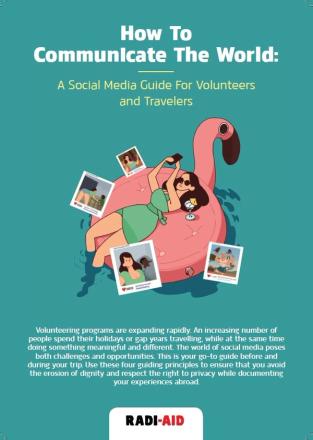Stories from our work
Stories from our work
How to communicate the world on social media?
2017
Is it okay to post pictures of strangers' kids from a Norwegian school or daycare? Probably not. And it shouldn't be any different when we travel abroad.

We're traveling more than ever, whether it's for exchange programs, volunteering, or backpacking. As a generation that's always been online, it feels natural, maybe even obligatory, to share our experiences with those back home.
A quick tap, and the whole friend list is updated. But what reality are we really sharing?
Volunteer tourism booming
Do a quick Instagram search under #volunteerafrica or #HelpAfrica, and you'll see the classic "Africa pictures" pop up: a white volunteer surrounded by African children, somewhere deep in the "bush", with the white volunteer at the center as "hero of the day." We've all seen them. And instinctively, maybe we've thought, "Oh, look at her, doing so much good and charitable work."
But something feels off. Haven't we progressed beyond this?
Volunteer tourism is booming. At the same time, the accessibility and use of social media have increased, creating both opportunities and challenges for how we share our experiences and the consequences of doing so.

Reproducing harmful stereotypes
Image sharing has gained attention in Norway, especially concerning privacy related to pictures of children. Ethical guidelines within aid organizations regarding image use have also become more prominent. When it comes to social media, however, everyone is their own editor, and there's no code of conduct.
But why don't we follow the same norms while traveling that we would at home?
It's natural to get caught up in the moment and the intense experience of encountering other cultures. On social media, we can be spontaneous in what we choose to publish, and many of us share our experiences uncritically. The focus often turns to the "exotic", and what gets the most attention are pictures with children and ourselves. With the best intentions, we end up spreading oversimplified information to friends and acquaintances. What many of us don't realize is that the selfie we take can rob people of their right to privacy and reinforcing harmful stereotypes of "us" and "them."
Social media guide
In SAIH, we work to counteract this. We want to spread awareness that we need to portray the world in a more nuanced way.
We are behind the internationally recognized 'Raid-Aid Awards,' which for years celebrated the best and worst in fundraising communication. We've also created a series of satirical videos recognized as "best practice" in development communication by OECD (2012), one of the best "Ads Worth Spreading" by TED (2014) and included in The Guardian's list of "the best parodies of aid" (2014).
In 2017, we teamed up with the creators of the satirical Instagram account, Barbie Savior, to provide useful tips for young people traveling abroad for the first time. The guide "How to Communicate the World" has been used by commercial actors, organizations, and educational institutions. Over time, the guide was translated into several languages.
Are you thinking about how you portray others on social media?
This is always important, but especially when you're traveling. Each of us can contribute to combating harmful stereotypes — one post at a time.

More stories from our work


Stories from our work

